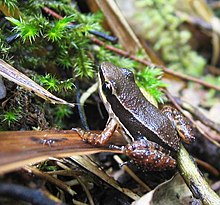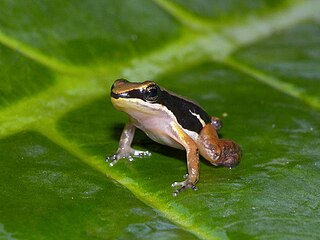
Colostethus is a genus of poison dart frogs native to Central and South America, from Panama south to Colombia, Ecuador, and northern Peru. Their common name is rocket frogs, but this name may refer to frogs in other genera and families, following the taxonomic revision of the genus in 2006.
The sky-blue poison frog is a species of poison dart frog. It is endemic to Peru and known from the lower eastern versant of the Andes in the upper Amazon basin of the San Martín Region.

Dendrobates is a genus of poison dart frogs native to Central and South America. It once contained numerous species, but most originally placed in this genus have been split off into other genera such as Adelphobates, Ameerega, Andinobates, Epipedobates, Excidobates, Oophaga, Phyllobates and Ranitomeya, leaving only five large to medium-sized species in the genus Dendrobates. All the other genera used to be grouped in with Dendrobates because it was previously thought that all brightly colored poison dart frogs came from the same ancestor but this has since been proven to be incorrect. Dendrobates and Phyllobates evolved conspicuous coloration from the same common ancestor but not the same as any of the other genera listed above.

Epipedobates is a genus of poison dart frogs native to northern South America west of the Andes, including the western slopes. Common name phantasmal poison frogs has been suggested for the genus.
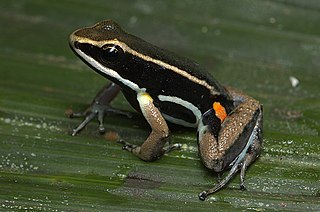
The Aromobatidae are a family of frogs native to Central and South America. They are sometimes referred to as cryptic forest frogs or cryptic poison frogs. They are the sister taxon of the Dendrobatidae, the poison dart frogs, but are not as toxic as most dendrobatids are.

The blue-bellied poison frog or bluebelly poison frog is a species of frog in the family Dendrobatidae.
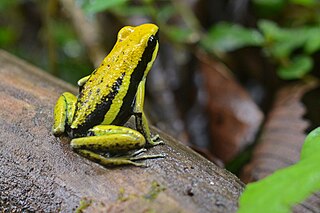
The pleasing poison frog is a species of frog in the family Dendrobatidae endemic to Peru. The specific name bassleri honors Harvey Bassler, an American geologist and paleontologist.

The Manú poison frog is a frog species in the family Dendrobatidae found in southern Peru and Brazil. It can be found in the drainages of the Manú, Urubamba, Upper Purus and Ucayali Rivers. It can also be found in Serra do Divisor National Park and Alto Juruá Extractive Reserve.

The Peru poison frog, also known as Peruvian poison frog, Peruvian poison-arrow frog and emerald poison frog, is a species of frog in the family Dendrobatidae. It is found in eastern Peru and western Brazil. Its natural habitats are primary premontane and subtropical or tropical moist lowland forests, rivers, freshwater marshes, and intermittent freshwater marshes.
The Oxapampa poison frog is a species of frog in the family Dendrobatidae endemic to Peru near Oxapampa, in the Pasco Region. Its natural habitat is montane tropical rainforest. It is a very rare species threatened by habitat loss.

Hyloxalus is a genus of poison dart frogs, family Dendrobatidae. The genus is distributed in Central and South America, from Panama south to Peru, along with Venezuela, Colombia, and Ecuador. They also inhabit the eastern foothills of the Andes in Bolivia to Venezuela, east to the upper Amazon Basin.

The Dendrobatoidea are a superfamily of frogs.

Ameerega is a genus of poison dart frogs in the family Dendrobatidae. These frogs live around rocks that are nearby streams. They are found in central South America north to Panama. It contains many former species of the genus Epipedobates.

Hyloxalinae is a subfamily of frogs in the family Dendrobatidae.

Adelphobates is a small genus of poison dart frogs. They are found in the central and lower Amazon basin of Peru and Brazil, possibly Bolivia. It was originally erected as a sister group to the Dendrobates and Oophaga genera. The validity of the genus is still being discussed, with the alternative being "Dendrobates galactonotus group" within Dendrobates. One species originally placed in this genus as Adelphobates captivus has since been moved to the genus Excidobates erected in 2008.
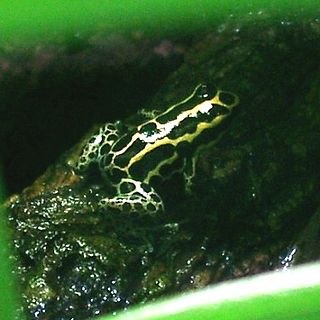
Ranitomeya is a genus of dart poison frogs found in Panama and South America south to Peru and Brazil, possibly into Bolivia.

Dendrobatinae is the main subfamily of frogs in the family Dendrobatidae, the poison dart frogs of Central and South America, found from Nicaragua to the Amazon basin in Brazil.

Anomaloglossus is a genus of frogs in the family Aromobatidae. The genus is endemic to the Guiana Shield in northern South America. It used to be placed in the family Dendrobatidae, and is still placed in that family by some sources. The name of the genus, from the Greek anomalos and glossa (=tongue), refers to the unusual tongue bearing the median lingual process, the only unambiguous phenotypic synapomorphy of this genus.

Rheobates is a genus of frogs in the family Aromobatidae. It is endemic to Colombia. These are cryptically coloured frogs with extensive toe webbing. The name Rheobates is derived from the Greek words rheo and βάτης bátēs, in reference to the riparian habitat of the type species Rheobates palmatus. They are associated with streams in sub-Andean forests and foothills of the Andes at low to medium altitudes.
Epipedobates narinensis is a species of poison dart frog. It was first described as a distinct species in 2008.
